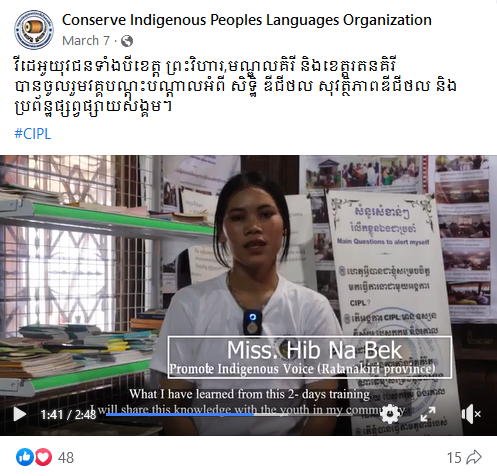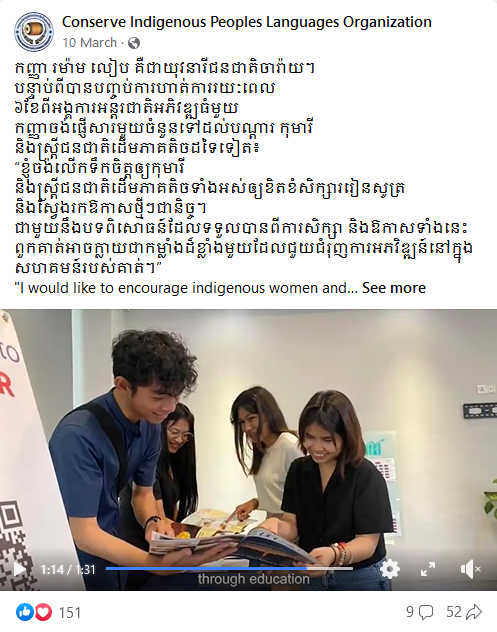The training covered the topics of human rights, digital rights, digital media, and digital trends in Cambodia. Pre and post-test results illustrated that 73% of the trainees improved their knowledge regarding digital security and rights.

Similar Stories
Improving access to essential EIA reports
To improve access to meaningful and reliable natural resource management (NRM) and environmental protection data, ODC has taken a significant initiative to ensure the availability of Environmental Impact Assessment (EIA) reports. Providing the public with EIA reports is critical to ensuring transparency, accountability, and informed decision-making. It enables the public to understand the potential environmental consequences of proposed projects and hold decision-makers accountable. The public\'s access to this information promotes informed debate, ensures that all stakeholders\' voices are heard, and supports the prevention of environmentally harmful projects. This transparency fosters trust among the government, industry, and the community, resulting in improved environmental outcomes. This will help the relevant stakeholders and community to monitor the project implementation. However, the advocacy for disclosure poses substantial challenges. As a first step, ODC organized a series of workshops on the disclosure of environmental data, specifically EIA reports. These workshops were attended by CSOs, the Ministry of Environment\'s EIA Department, and other stakeholders. During these sessions, ODC emphasized the importance of making EIA reports public and encouraged collaboration to achieve this transparency. In addition to the workshops, ODC wrote several official letters to the MoE and partners, urging them to release the EIA reports. This advocacy was addressed through both formal and informal settings. Despite the government\'s initial stance of \"No Disclosure,\" there was one notable development: ODC was able to find alternative locations where environmental data and reports are stored. While direct requests to the government for EIA report disclosure have yet to make results, ODC identified an alternative approach, i.e., that CSOs with access to EIA reports can share them. Through numerous discussions and advocacy efforts, ODC raised critical questions, including, \"Why can\'t these reports be shared when regulations require their disclosure?\" Furthermore, \"Why aren\'t the CSOs sharing the reports they have?\" ODC continued to lobby key stakeholders through discussions, official requests, and workshops. These persistent efforts, supported by USAID through CSS, returned a significant breakthrough: an agreement to share more than 90 draft EIA reports from the Development and Partnership in Action Organization (DPA). Most of these reports focus on major projects in the extractive industrial sector that interest researchers, advocates, journalists, and CSOs.
Renewed purpose: Raising awareness on sexual Harassment one community at a time
Sinath is a leader of a commune-based organization (CBO) in her community. She started volunteering with Banteay Srei in 2008. Sinath wasn’t always very confident and active in her community. Living in a small community, Sinath faced pressures related to societal and family norms, stereotypes, and judgements. She took on traditional roles of taking care of her children, husband, and in-laws and didn’t feel brave enough to socialize outside the house and attend village activities or meetings. After becoming a volunteer with BS, Sinath had more opportunities to attend different events with BS. Those events – meetings, trainings, public forums, study tours – in her province and beyond have helped her to build knowledge and experience. Now, Sinath has a better understanding of leadership and her self-worth. She has also gained new skills such as public speaking, communications, planning, business, community mobilization, and facilitation. Sinath continues to equip herself with new knowledge and skills. In 2023, she learned and gained new knowledge from BS on sexual harassment. Sinath is a member of one of the five CBOs selected by BS to receive sexual harassment training. Sinath finds this new knowledge very important for her and other women in her community. After the training, she is able to recognize different types of harassment as well as harmful and discriminatory jokes often made by people around her. Sinath believes that lessons on sexual harassment can help men to understand and cease their discriminatory behavior that leads to sexual harassment. After the training, she has applied what she learned in her daily life and among her monthly saving group that she belongs to. Her peers showed a lot of interest in the subject and expressed that this would help them shift their perception and inspire some positive changes in their daily lives. For the future, Sinath plans to advocate on the issue of sexual harassment in her village by using operational funds received from Village Savings/Credit Group program. Along with the advocacy effort, she also plans to raise awareness on other topics such as importance of educating children, the impact of young marriage, gender-based violence, leadership, and positive thinking.
CSS’s Intern Romam Leap shares her internship experience
CSS produced a short video to highlight the internship experiences of former communications intern and Jarai indigenous youth Romam Leap. The video was very well received by the public on social media, generating approximately 150 reactions, 52 shares, and 2,700 views on Facebook


